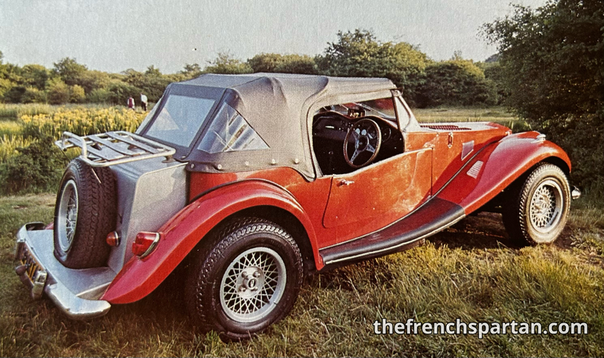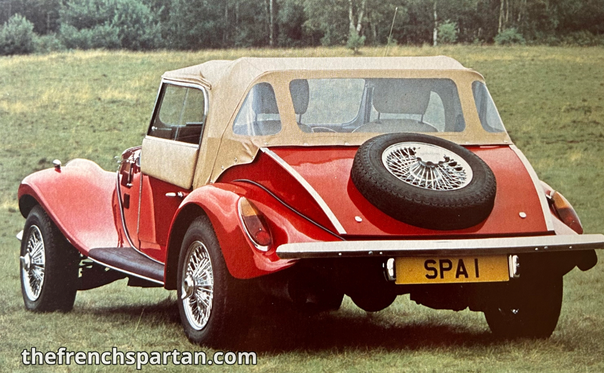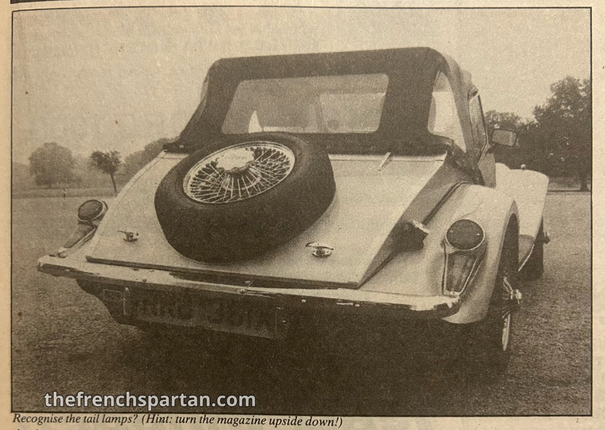Features
The Roadster was produced from 1973 to 1995 by Spartan Cars, and will remain the best known and representative model of the brand.
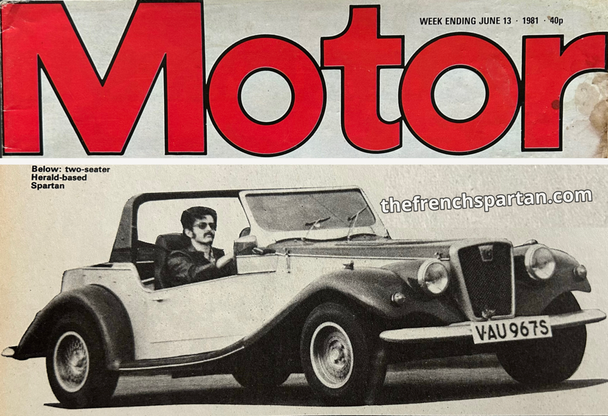
The French Spartan is a Ford based (Spartan Mk II, produced from 1983 to 1995).

Under the impetus of Spartan Nederland, many Spartan were marketed in this contry.

Spartan Car Compagny had produced 4,000 vehicles, mainly Roadsters witch had been in the number of 3000, and exported to 24 countries, as we can see on this advetisement :
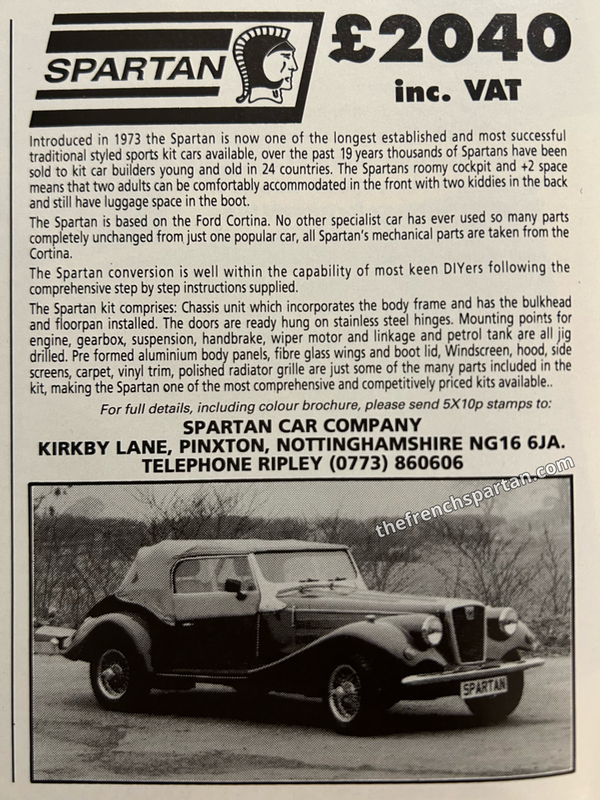
Of the 3000 Spartans produced, 2000 were Triumph-based, and 1000, the most recent, where Ford-based.
The first Spartan, based on Triumph, had a rather "square" rear :
The Spartans who came next, on a Ford base had a much more profiled rear :
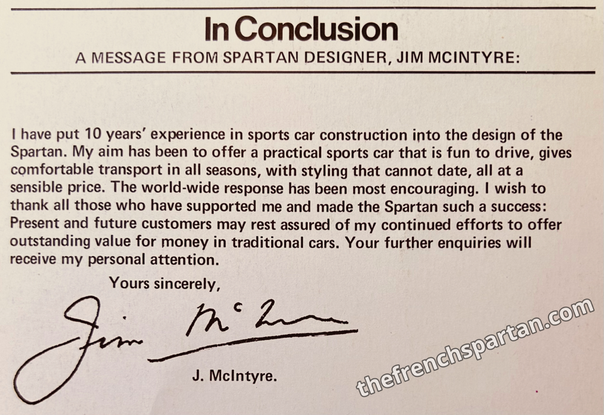
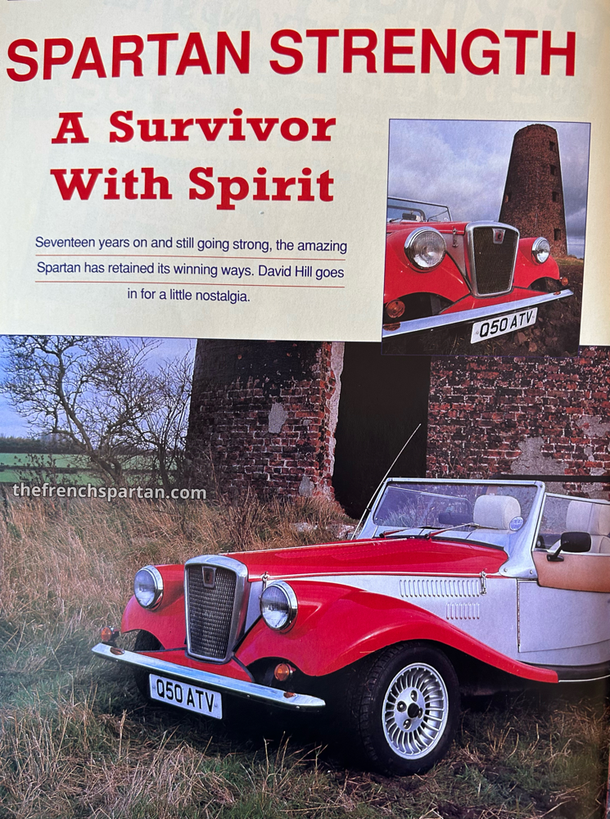
In France, there is a fewer than 40 examples of Spartan left.
Important dates for The French Spartan
- First registration : july 1987
- FFVE certificate for obtaining a collector vehicle registration document : July 2017
- Start of the complete renovation : May 2022
- Technical Inspection : July 20, 2024
- Provisional French enrolment : July 2024
- French registration : October 2024
Specifications
|
SPARTAN Roadster Mk2 |
||||
|
Ford - RWD |
||||
|
Outside length : |
3810 mm |
|||
|
Width : |
1588 mm |
|||
|
Height : |
1258 mm |
|||
|
Wheelbase : |
nc |
|||
|
Weight (approx.) : |
940 kg - (712 kg for 1599 cm3 version) |
|||
|
Top speed : |
195 km/h |
|||
|
0-100km/h : |
9,7s |
|||
Engine
|
Ford Sierra 2.0i DOHC Engine 125HP 92KW 5600RPM |
||||
|
DOHC Engine, N9. |
||||
|
Type of engine : |
4 cylinders in line |
|||
|
Energy : |
Petrol |
|||
|
Arrangement : |
Front longitudinal |
|||
|
Fuel supply : |
Injection |
|||
|
Distribution : |
2 overhead camshafts |
|||
|
Distribution chain : |
Yes |
|||
|
Number of valves : |
2 per cylinder |
|||
|
Displacement : |
1998 cc |
|||
|
Power : |
125 horses à 5600 tr/mn |
|||
|
Engine couple : |
17,5 mkg à 2500 tr/mn |
|||
|
|
||||
|
Manual Gearbox MT75 5/1 |
||||
|
Gearbox : |
5-speed |
|||
|
Fiscal power : |
11 horses |
|||
|
Type : |
Propulsion |
|||
|
Traction control : |
No |
|||
|
ESP : |
No |
|||
Lubricants
Each engine has its features and ils specificities.
The information provided below is only related to that of The French Spartan.
In all cases, the maintenance of a car must be entrusted to automotive professionals.
|
Ford EU - Sierra 2.0i DOHC 125HP 92KW 5600RPM |
||||
|
Engine DOHC, N9. |
||||
|
Lubricating capacity : |
4,5 litres |
|||
|
Filter capacity : |
0,5 litre |
|||
|
Recommandation : |
Engine oil 10W-40 Semi Synthetic |
|||
|
To change : |
Every 10000 km / 12 months |
|||
|
|
||||
|
Manual Gearbox MT75 5/1 |
||||
|
Lubricating capacity : |
1,2 litres |
|||
|
Recommandation : |
Gearbox oil 75W-90 GL-3/4/5 Premium Synthetic TDL |
|||
|
To control : |
Every 20000 km / 24 months |
|||
|
Alternative : |
Gearbox oil 75W-80 GL-5 Premium Synthetic MTF |
|||
|
To control : |
Every 20000 km / 24 months |
|||
|
|
||||
|
Rear differential |
||||
|
Lubricating capacity : |
0,9 litre |
|||
|
Recommandation : |
Transmission oil 80W-90 GL-5 Mineral Hypoïd Oil |
|||
|
To control : |
Every 20000 km / 24 months |
|||
|
|
||||
|
Hydrolic brake system |
||||
|
Recommandation : |
Brake fluid DOT 4 |
|||
|
To change : |
Every 60000 km / 36 months |
|||
|
|
||||
|
Power steering |
||||
|
Capacity : |
0,75 litre |
|||
|
Recommandation : |
Automatic transmission fluid Dexron II-D |
|||
|
To control : |
Every 10000 km / 12 months |
|||
|
|
||||
|
Cooling system |
||||
|
Capacity : |
7,3 litres |
|||
|
Recommandation : |
Coolant -36°C |
|||
|
To change : |
Every 60000 km / 24 months |
|||
The chassis
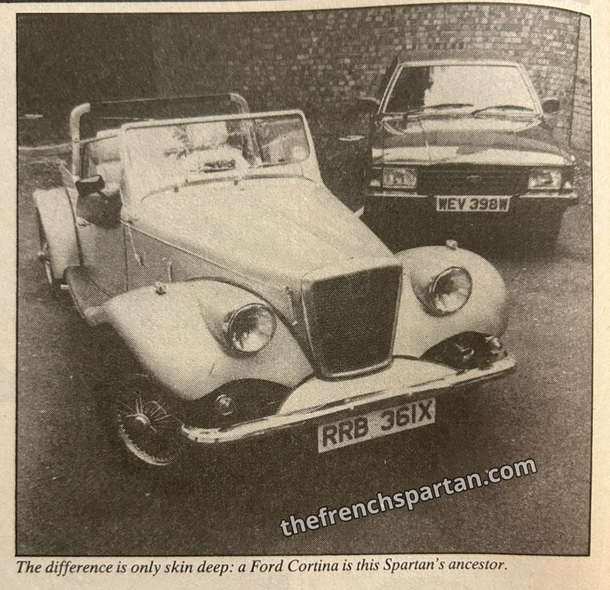
Designed with 2mm steel sheets, it gave the Spartan an excellent rigidity.
Below, being assembled at Spartan's Pinxton factory :

|
Ford Cortina Mk IV |
||||
|
Fuel tank |
||||
|
capacity : |
54,1 L / 11,9 UK gallons |
|||
The bodywork
Here are the bare body parts of a Spartan :
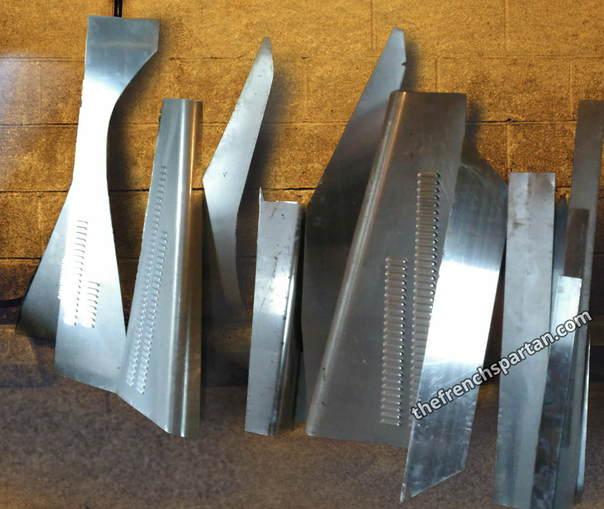
At the time, the assembly instructions were worded as follows :

Rims and tires
-
Rims : Chromed MWS 15” x 5.1/2” hub 42mm 8tpi 72 spoke Tubeless
-
Tow-eared
-
Tires : 185/60R15
Lighting
-
Headlight : Lucas P700 x 2
-
Night light fender : Lucas L516 x 2
-
Long range light : Lucas SLR576 x 2
-
Rear lights : Ford Anglia
The Spartan Mk2, based on Ford, received rear lights from Ford Anglia (so British !), as in the photo above, or from Austin 1300 (British too !) :
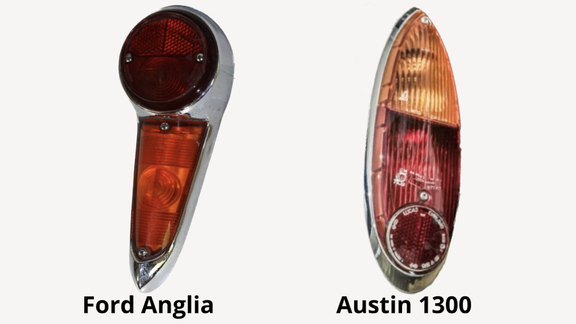
Color
The French Spartan will be Luxcom’s Red
The exact reference of the painting is :
FORD P 9 4Z RADIANT - SPANISH RED XSC2251

There are also beautiful white, blue and green copies, a priori in equal parts for just under 20% each, the other colours and the two tones remaining more marginal, like Olive's magnificent two-colour (which is looking for side windows, if you can help him...) :
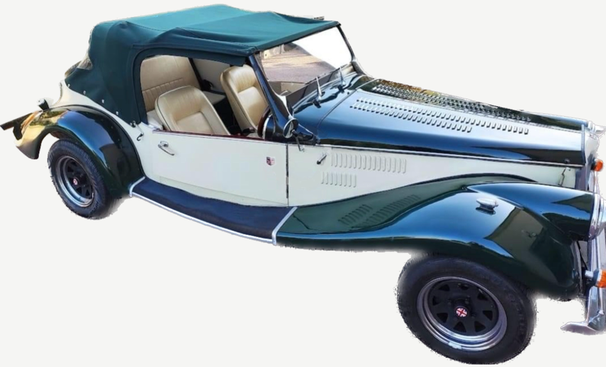
A beautiful blue Spartan

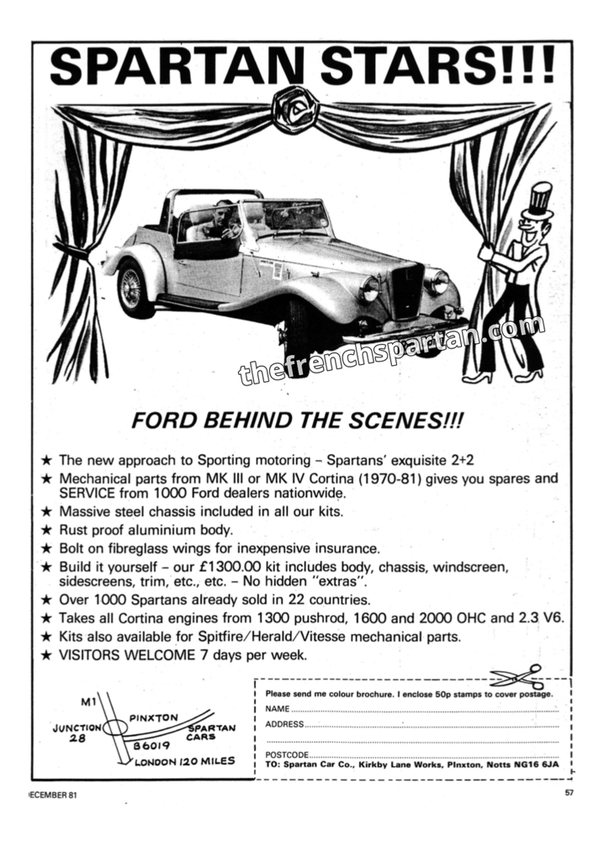
His Spartan had also made the cover of SPORTS CAR MECHANICS magazine where she was found on inside pages :
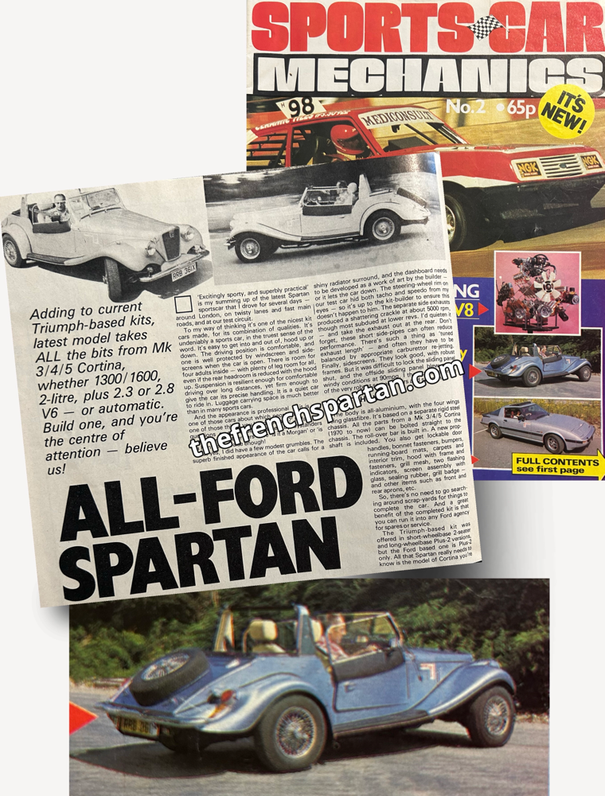
The Spartan logo
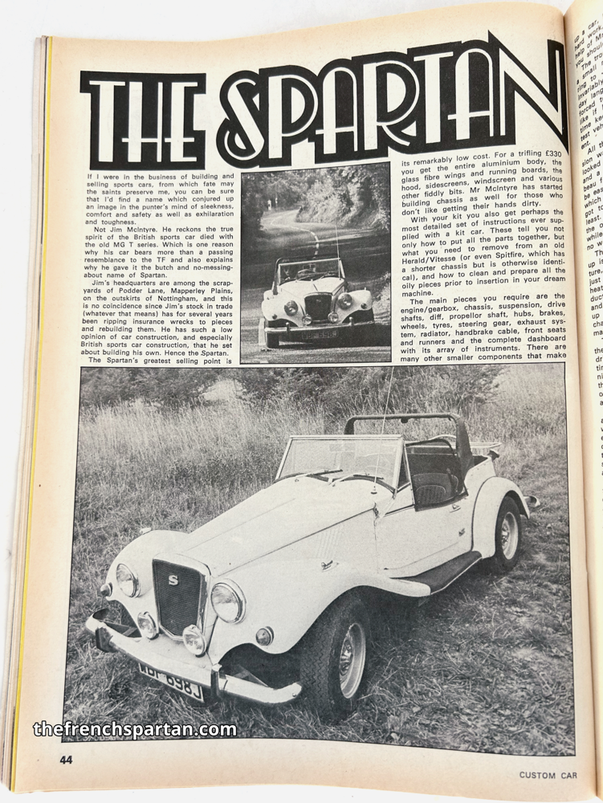
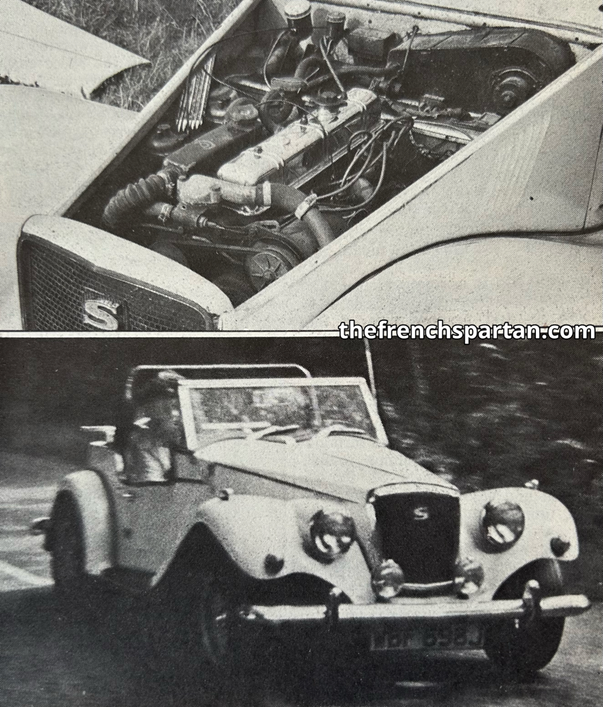
Originally, the "S" symbolising the brand was the acronym that characterised MORRIS commercial vehicles.
This "S" was positioned on the middle of the grille initially original WOSSELEY on the 18-85 model.
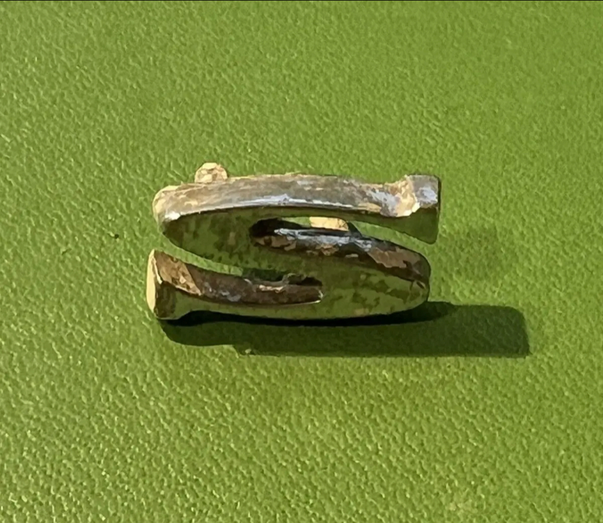
It will be necessary to wait until the end of 1975 to see the famous brand logo arrive, and that the enamel Spartan badge is then integrated into the upper part of the redesigned grille by Spartan Car Company to receive it.

Here, in 1983, one of the last Triumph based Spartan, with the famous grille :
